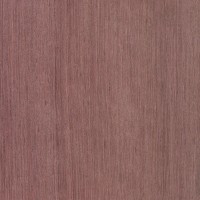

The wood exhibits a medium to high luster. The grain is typically straight, sometimes wavy, roey, or irregular. A treatment with Armorall, the car finish product, under lacquer is reported to hold the color well. Treatment against the effects of ultra-violet rays has been suggested to maintain the original color of the wood. Peltogyne timbers are reported to vary widely in color between, and probably within, species. Presence of minerals in some boards may cause uneven coloration and steaming is reported to affect the color. Color variation between boards is reported to be moderate to high. Prolonged exposure darkens the wood to a dark-purplish brown or dark brown, but the original color can be restored by recutting the wood. The heartwood is initially dull brown, but it rapidly changes to a bright, vibrant purple. The color has also been described as pinkish cinnamon with light brown streaks, and is usually about 2 to 4 inches (5 to 10 cm) wide. The sapwood is creamy white or off-white in color, and is very distinct from the heartwood. Mature Purpleheart trees are usually tall and attain a height of about 100 to 150 feet (30 to 45 m), and a diameter of up to 48 inches (120 cm), usually between 18 and 36 inches (45 and 90 cm). Although it has not found wide demand, Purpleheart is reported to be available on the US market in both the lumber and veneer forms. It is reported to cost more than mahogany but less than teak. Supplies are reported to be ample, but the wood is fairly expensive. The material is exported at a low but regular rate. The International Tropical Timber Organization (ITTO) reports that timber production from this species is regular. It is not known at present whether some material from this species is available from sustainably managed, salvaged, recycled, or other environmentally responsible sources. They are reported to be most common in the Amazon basin, and are also found in Colombia, Guyana, Surinam, and Venezuela. porphyrocardia, which grow in Central America and tropical South America, from Mexico to southern Brazil. The commercial name Purpleheart is reported to refer to timber produced by about 20 species, including P. The environmental profile of this species within its natural habitat has not been officially assessed. Typical useĬabinetwork (high class furniture), Sliced veneer, Sculpture, Ship building (ribs), Exterior joinery, Stairs (inside), Glued laminated, Interior joinery, Musical instuments, Tool handles (resilient woods), Current furniture or furniture components, Interior panelling, Flooring, Ship building (planking and deck), Exterior panelling, Heavy carpentry, Vehicle or container flooring, Turned goods, Wood-ware.Common Names: Purpleheart,Amarante, Amaranth,Guarabú, Koroboreli, Morado, Nazareno, Palo morado, Pau roxo, Pelo morado, Purperhart, Saka, Sakavalli, Tananeo, Violetwood. In the USA, Purpleheart/Amarante is used to make high class coffins. boardwalks, gardens, ship building piles, bridge constructions, flooring, joinery, panelling, heavy carpentry, vehicle or container flooring parquet, high class furniture, musical instruments, sculptures, panelling, sliced veneer, stairs, flooring, joinery, wood ware, tool handles, high class coffins. This exclusive species is used for several purposes such as: It is durable to moderately durable in ground contact and it is durable to dry wood borers sapwood demarcated (risk limited to sapwood).
Purple heart tree wood windows#
Purpleheart fulfills the regulation of the Dutch KOMO certification for windows and doors. Sometimes these veins can bleed, also after finishing. Gum veins can be found in some botanical species, showing a pattern of stripes on the surface. Purpleheart dries normal to slowly with a tension to small surface checking. Finishing and gluing are in accordance with the Dutch regulations for windows and doors. Density at 12 % moisture content: 0.87 g/cm3.Machining goes well with a smooth result but requires power. The grain is straight and the texture is fine to medium. Amarante/Purpleheart is a species with a tendency to bleed. It has a fine stripy pattern, and a slight lustre. There is a possible presence of internal stresses.

In time it darkens to dark brown with light. Purpleheart ´s heartwood has directly after moulding a pale brown colour, which quickly changes to purple after exposure.


 0 kommentar(er)
0 kommentar(er)
